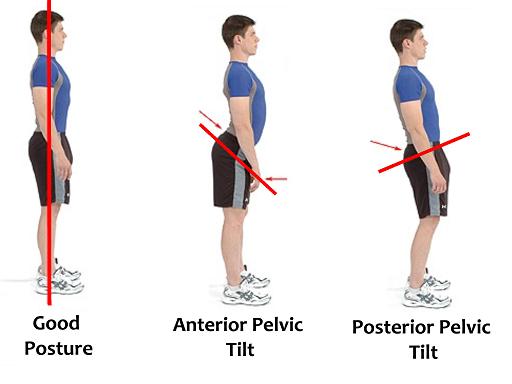Whatever way it really doesn't matter, front, back, overhead, 1 arm, 1 leg (seriously - pistols {difficult}), but seriously I love em. It takes a ton of muscles and a ton of focus, and lately it seems like everyone is doing them. So I want to talk about them...
Now this isn't about high bar / low bar - you can read all about that here (by the way, that's going to become a new favorite site located on the right hand side of this post).
What I want to talk about is pelvic position. Specifically, anterior pelvic tilt - anterior (i.e. forwards) - anterior pelvic tilt involves an exaggeration of the natural lumbar curvature (the S-shape of the spine) and is caused from the top of the pelvis coming down. Scientifically speaking, the hip extensors are shortened and the hip flexors are laxed. The abdominal muscles are tightened.
A good squat starts with an ability to stand correctly with load. As the squat is performed, we want to maintain good position, if the pelvic position becomes compromised (and I should indicate that I have only experienced coaching anterior pelvic tilt) from the beginning a whole slew of bad things could potentially happen. And since we like to stay ahead of the game in regards to technique, let's take a look at what could happen:
Is squatting problematic for you because you feel it way too much in the lower back?
Do you tend to lean way to far forward when squatting?
Do you have trouble with the lockout on your deadlift and arch your back to complete it?
Do you tend to get a lot of hamstring strains or pulls?
Do you often have lower back pain?
Do you often have calf cramps or shin splints?
Thank you to taylorednutrition for the information and the picture. Now we have two ways of dealing with this particular issue:
1) Mobility of the area (check out KStar's blog here) and there are other links as well
2) Strengthening of individual areas or performing the movement (aka the squat) correctly.
This has some high level talk, a little deeper dive information and some medical information. I am not a doctor, not a therapist, and this is not a diagnosis, but what we can tell is that there is good information for people to become aware of, a more body aware athlete is a better athlete in my humble opinion.
Good luck and keep squatting.
-Coach Tony
"Try not! Do or do not! There is no try…"
Yoda

No comments:
Post a Comment